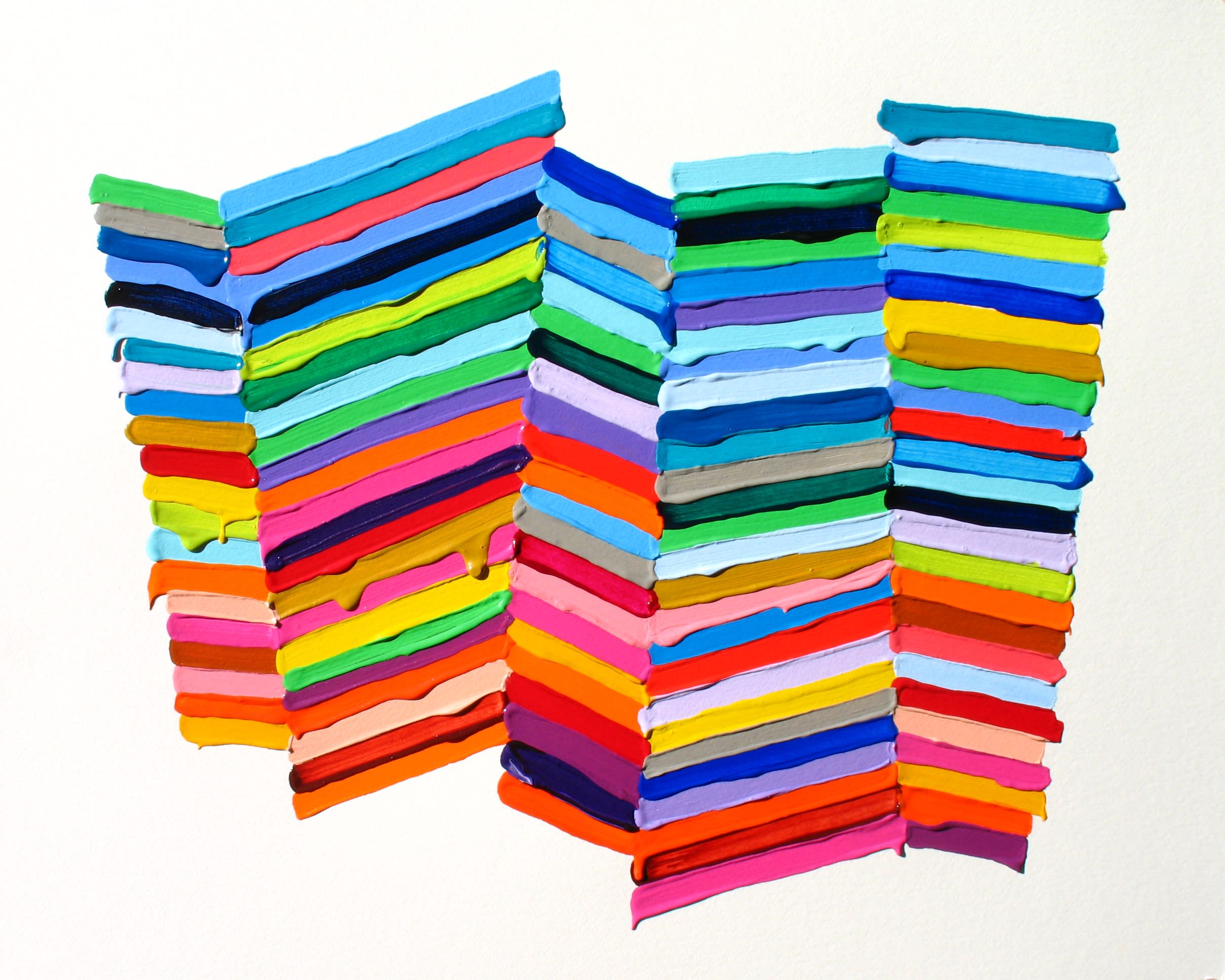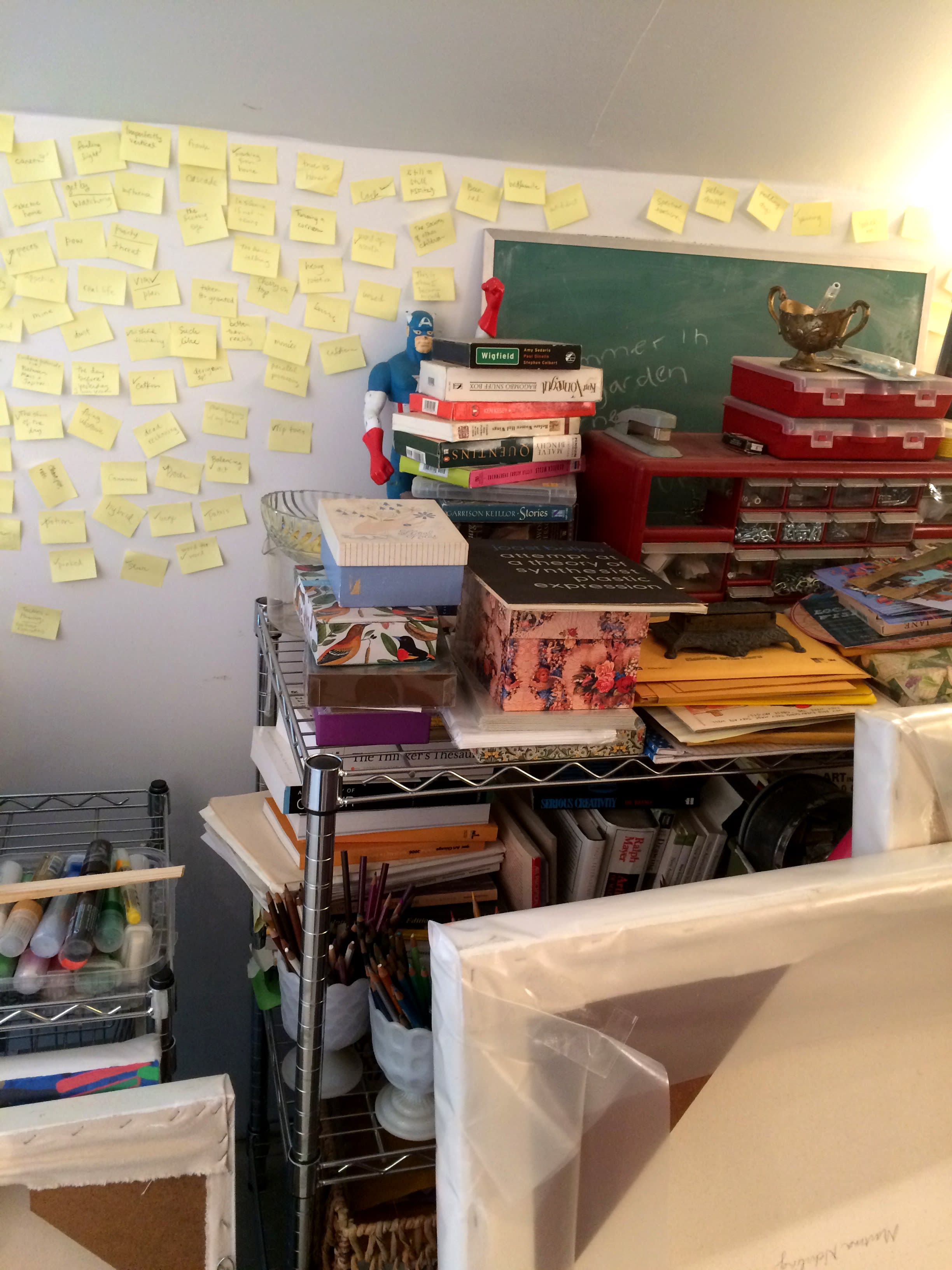
Every week, we'll be sitting down with one of our gallery artists to discuss their work, process, inspiration, and stories. This week we're speaking with Martina Nehrling.

"Apophony"
Martina Nehrling's eye-catching work is colorful, energetic, and invigorating. Her distinctive style of staccato brushstrokes allows her use of highly saturated color to shine, playing off the relationships of the color wheel to create a vibrating tension throughout the work. Nehrling works in a rhythmic minimalism, breaking down painting to its essence yet reveling in its sensational possibilities, guiding the viewer's eyes through a journey around the plane. Nehrling spoke with us from Chicago to discuss finding her voice as an artist, honing visual rhythm, and the controversial role of optimism in art.

Photo courtesy of the artist
What are your earliest memories relating to art?
Each of my parents had a sibling who identified as a visual artist, and were proudly celebrated as such by the family. So when early on it became clear that my most contented time was spent drawing, painting, and making things I was indulged and encouraged. Like any other inherited trait it was just taken as a given that I was another artist in the family. From the beginning this identity was forged in a supportive framework that informed how I engaged the world. With experience and hindsight, I humbly value all the more the substantial faith with which my early artistic impulses were received. I cannot understate the significance of this, as I was a sensitive kid whose family circumstance was sometimes chaotic. My grandma, most influential, keenly noted my attraction to patterns and their derivations, visual and otherwise. She kept art materials that were mine alone to use. I also had the good fortune to attend a school district where extracurricular programs were available for artistically talented kids from kindergarten through twelfth grade. All those visits to museums and extended time dedicated to art-making was a kind of church for me.
Your work has a very distinct style and vocabulary. How did it evolve to become what it is today? If it's even possible to put into words, what are your thoughts on finding your own voice as an artist?
My work now looks more like the genuine impulses of my childhood art making than much of the imagery I created during most of my art school years, when producing such brightly colorful work was discouraged. It was considered decorative, and that was not Serious Art. Midway through graduate school, still trying to keep my proclivity for a full spectrum of color tamped down, I responded to a moment of indecision with a smart-alecky move. In a simple figure/ground composition I tested a few colors one brushstroke next to another until I filled in the entire shape with individual strokes of vivid color. I was sort of in a trance, fully expecting I'd come in the next day and wipe it all away. But I didn't. In fact I made another one of these images where a loose grid of individual vivid brushstrokes banded together in a color field. My acceptance of this imagery wasn't instantaneous, but I knew I was in more authentic territory so with some trepidation I let the marks extend to the edge of the canvas. Importantly, around this time I read David Batchelor's, Chromophobia, and it served as the final piece of encouragement I needed to exploit my bad manners, if that is what my use of color was. When next my work was criticized as decorative rather than defending it I said "Yea, OK, let's talk about that."

Photo courtesy of the artist
Could you walk us through your process, from finding inspiration for an idea to deciding that a work is completed?
Sometimes I say with amusement that my titles tell you all you need to know about my work. It's an oversimplification but there is some truth to it. A wall in my studio is littered with Post-its on which I've written words and phrases that reflect concepts that beg exploration, and often become titles. Likewise there is a chalkboard of such notes in my kitchen and pages in my sketchbook dedicated to listing these "image sparks." These may be an idea or query I find already ridiculously visual, unusual, confounding or provocative in some way. If some sense of compositional structure is immediate, I've learned to trust it. Though, sometimes it's a search. A nice momentum occurs when the work provokes itself. That's when I'm compelled to begin a piece by following a thread, some formal relationship, compositional variation, or conceptual focus developed in an earlier piece, and so on. Regarding the physical process, my work is very much built - one brushstroke at a time. In early stages some compositions resemble a Scantron sheet or player piano roll. As for knowing when a piece is complete, that's an instinct one develops. When to trust the tension that must remain for the whole to be resolved might be the moment of greatest creative autonomy for an artist.

"Mixed Use"
Color is celebrated in your work. What is your relationship with color like - what do you consider its power to be, and where do you find inspiration for your palette?
Color has always been very compelling to me. It has space and I am drawn into it. Not even a single color alone is one dimensional to me. Sometimes in a limited selection a color can operate as an example, say, of blueness. Through a large selection I try to use colors as unique samples where, though it may repeat, one brushstroke of blue is distinct in the presence of counterpart colors of blue. Complementary colors, those opposite from one another on the color wheel, buzz with tension due to the leap across the maximum unseen analogous colors in between. Still in a wide range of colors, such as the palette I choose, precisely because it so closely suggests but does not complete the total harmony of a full spectrum, the gaps have an emphasis, a beat that is the subtlety nuanced visual rhythm I enjoy working with. Curiously, I usually have in mind one or two colors that seem to operate like the cement holding my palette together. That color slowly evolves over time. Lately I feel that way about a transparent gray green. Regarding the nature of my palette, as a wide range of highly saturated color it is not entirely unnatural, nor is it surreal, but it is hyper, almost physical yet conceptually specific to the materiality of an artist studio. I appreciate its insistence, its unapologetic hysteria, its mirth and its madness. I wonder if I will think differently about this later but this palette seems very present tense.
Your work also has a strong sense of rhythm to it. What draws you to exploring this quality, especially as an artist who has chosen to work in a motionless medium (rather than, say, video or performance art)? What is it inspired by?
While much about color motivates me I have come to think rhythm is central to the content of my work. I am not clinically synesthetic but I seem almost to hear visual rhythm as I paint. I don't really see the imagery moving, but much like the chatter in my mind, nor does it pause. Unlike a time-based medium, it's as if all the action is happening at once, and perhaps uniquely with each viewing when we're lucky. To continue what I mentioned above, the rhythm of color itself in my palette is a result of the discontinuity due to the full spectrum being suggested but not complete. I perceive this presence of absence, those skips in a continuous prismatic array of color, as a pulsation that to me resonates very much like the emotional incongruity in the content of the written notes I mentioned. Those little provocations I want to remember or try to sort out in some way, overall they feature the constancy of the mundane and at the same time the relentless clashing of beauty and horror. The rhythm in my work is inspired by this rich cacophony of daily life to which I am tuned to by nature seemingly without a filter for better or worse.

Photo courtesy of the artist
The scale of your work ranges greatly from small works on paper to pieces that take up entire walls of a gallery. Do you find that the size of your work dictates the particular style of the piece, or is it the other way around - you find yourself with an idea that can only be portrayed in a grander scale?
It works both ways. I don't usually mind being requested to work in a specific size, say for a commission. It's like being given a certain amount of time in which to tell a story, and I enjoy the creative challenge to make the right selection of information. I always want the content to be specific to the size so that does determine almost everything about the work. Interestingly, sometimes smaller works seem more difficult because there is less space for problem solving and more at stake with every mark.

Photo courtesy of the artist
Many people are drawn to your work because they consider it to be so joyful. Would you agree? If so, was it a conscious decision to establish a happy, positive mood in your work?
Someone once introduced me as the happiest person he knows. I immediately thought it'd be far more accurate to call me very appreciative, or more insightful to say I'm a hard working optimist. I don't know if it's any easier to be a born pessimist but the world often provides a lot of pushback for an optimist. Of course, being true to our nature is the only way to live an observant and authentic life. Optimism is not always cool, yet I believe it's necessary, important, frequently requires bravery, and sometimes can even be a radical action. So, yes I understand that my work is perceived as joyful and I don't deny it. I only want to say that it's in equal measure to a consideration of what's at stake without it. My exploration of what it means to be here produces imagery that at times functions for me as musing or ranting in lush celebration, and at other times a high-pitched lament, or raucous rebellion.

Photo courtesy of the artist
How has your work been evolving lately?
I've spent the winter thinking about visual rhythm in relation to syntax, semantics, and semiotics, identifying ways in which these concepts are already at play in the work, and considering how a conflation of such ideas could most fruitfully structure my creative decision making. Also I've been experimenting in search for a sculptural substrate for my imagery, a long time interest which so far continues as a process of elimination. Stay tuned!

"Spellbound"
Explore more of Martina Nehrling's work here.
Comments
Martina. I love how you do the brush strokes in different colors. Quite a change from your earlier works. One painting I always loved was the one of the dancers that hung in your parents living room. Love your work! Your parents/grandparents would be so proud of you.
So much fun to read and look. I love your inner optimist. I titled a painting Optimist several years ago. Embrace it! Thanks for this!
